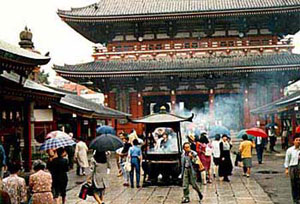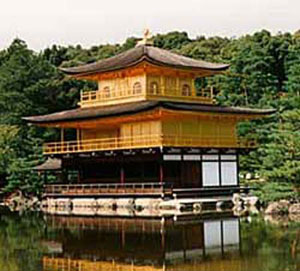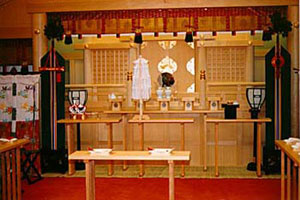 |
|
|
|
|
|
|
|
|
|
|
|
|
|
|
|
|
|
|
|
|
|
|
|
|
|
|
 |
 |
|
|
|
|
|
|
|
|
|
|
|
|

|
Notes from Tokyo, Osaka, and Kyoto
Land of the Rising Sun Tokyo Because the city is so big and seems overwhelming, first-time visitors are often tempted to take tours. We found a half-day Tokyo afternoon city tour to be disappointing. Highlights were the Tokyo Tower (not worth the detour) and Asakusa Kannon Temple, where the guide left us to wander alone. The temple, the oldest in metropolitan Tokyo, is impressive and can be visited on one's own.
The public bath suggested by the concierge at Westin Tokyo is Koshino Yu. Two hot springs that are accessible from Tokyo, about one and one-half hours away, are Kingugawa Onsen near Nikko and Hakone Yumoto near Mount Fuji. Each has a spa program that is set up for day guests. No reservations are needed. To learn the bathing rituals, watch the Japanese. Both spas have restaurants. For a delightful excursion close to the metropolitan area, travel to the ancient city of Kamakura, about a one-hour trip. Visit The Great Buddha and go on a walking tour of old temples and shrines, the most important of which is Engaku-ji. If you stop at seven shrines and get your tour card stamped (we didn't), you receive a prize. High on the list of other things to see in Tokyo are the Edo Museum, a reproduction of a 19th-century neighborhood in Fukagawa, and the Meiji Jingu Shrine, an example of Shinto architecture. Attractions Koshina Yu, 1-5-22, Azabu Juban, Minato-ku. Tel. 3401-8324. Open daily from 3 p.m. until midnight, closed Tuesdays. Hana Saryo, Kingugawa Onsen, 652-1 Ohara, Fujihara-machi Shioya-gun, Tochigi Prefecture. Tel. 288-76-8736. Call ahead for reservations and directions. Yuzo, 729 Yumoto, Hakone-cho Ashigara Shimo-gun, Kanagawa-ken. Tel. 460-5-5791. Osaka Osaka Castle, on the grounds of a large tree-filled park, is the primary tourist attraction in the city. Built by Hideyoshi Toyotomi, who succeeded in unifying the entire country in the 16th century, it was destroyed by fire and wars. The keep or the main tower was rebuilt 65 years ago using illustrations from folding screens owned by Lord Hideyoshi. The tower has galleries and an observation deck that affords fine views of the city. Springtime visitors have the pleasure of enjoying cherry and plum blossoms. Kobe, Nara and Kyoto are all a mere 30 minutes away from Osaka by train. Visit Kobe to see the remarkable rebuilding that has taken place since the earthquake. Stroll through the international section whose narrow streets are carved into the side of a hill. Visit Chinatown to snack on a delicious assortment of foods, which are sold from open-air stalls. Kyoto Kyoto, the capital of Japan from the eighth century to the mid-19th century, is also the cultural heart of the country. Boasting many temples and shrines, it is one of the best places to view ancient Japan. Although Nara is also filled with historic and religious sites, most tourists, who only have time enough to visit one of the cities, opt to see Kyoto. Some of the important attractions in Kyoto are: Nijo or Nijo-jo Castle was originally built in 1603 to be the official Kyoto residence of the founder of the Tokugawa Shogunate. Surrounded by stone walls and moats, the buildings and grounds clearly establish the castle as a nobleman's estate. Ninomaru, one of two beautiful gardens, is filled with stones designed around a pond and Seiryu-en, the other garden, has two tea houses. The Kinkakuji or Golden Pavilion is the most popular symbol of Kyoto and the one most often seen in photographs. Designated as a World Cultural Heritage Site, it is a three-story golden building whose shimmering presence is reflected in the pond that lies in front of it.
Kyoto Imperial Palace can only be seen with advance permission. Foreign tourists are given special consideration. Bring your passport to the Household Agency on the property by 9:40 a.m. for the 10 a.m. 30-minute, English-speaking guided tour and by 1:40 p.m. for the one that begins at 2 p.m. Kawai Memorial Hall displays the representative works of Kanjiro Kawai, a distinguished potter. The house is not only a museum, but an interesting example of what a large, luxurious and truly Japanese house looks like. Sanjusangendo, a temple filled with Buddhist images, was founded in 1164 at the request of the emperor, who was a devotee of Kannon-Bodhisattva. The hall is lined with 1,001 gold leaf plated statues of Kannon-Botsaku on a large altar supported by 34 pillars. Honen-in Temple is another Buddhist site that is particularly worth visiting for its tranquil setting. The approach to the main buildings along a dirt path with a thick canopy of trees is lined with sand arranged to reflect the changing seasons. Where To Stay Westin Osaka Although they are made of wood, the tubs in the two Japanese-style suites in the Westin Osaka feel to the touch like satin. No need for a massage to unwind. A soak in one of the tubs (wood holds the heat and has more resiliency than porcelain) is an antidote to a frenzied day in Japan's second largest city. In the style of the public baths, you scrub with soap and rinse in the shower before you steam in the bathtub. Then you crawl into the futon, as comfortable as a feather bed, and sleep comes instantly. The $550 price for the two-room suite, you can dine tatami-style in one of them, is reasonable when compared to the cost of staying in many ryokans (ancient inns). Should you wish, you can experience both worlds at the Westin– blissful Japanese-style accommodations and all the modern necessities in other parts of the hotel. The nearly two-year old hotel whose other rooms are a blend of Oriental and Western design has just about every convenience for which a visitor could ask. For example, bedside lamps have adjustable, built-in spotlights for reading so that a sleeping partner will not be disturbed. General Manager Charles Besford, who had long-time experience in the business, came to the project early. His suggestions helped with all the unique touches, such as the unusual clocks on the night tables, the newly-developed I-Key ceramic keys with memory chips, the delightful child care center and the authentic tea ceremony room where visitors might learn about the ritual from a master. Corner suites, there are 28 of them, are designed so that a guest might conduct business in the office section with the bedroom wing out of sight. The largest suites, both Oriental and European, are each decorated differently and include some antique furnishings. All seem fit for heads of state and, in fact, this is the lodging of choice when they are in town. The hotel's fitness club has a swimming pool and lots of equipment, including a rarely found relaxation chair with audio, visual and massage components. It's another great way to unwind. The lobby with its soaring atrium is contemporary and overlooks a large garden filled with streams, waterfalls, rocks and plants, providing a pleasant backdrop. Food choices vary with the chefs highlighting Mediterranean cuisine in Stella Maris, decorated in Southern European style, and Japanese food in Hanano where sushi, tempura, teppanyaki and several hot pots are served in different settings. Complimentary shuttle buses go to and from JR Osaka Station three times each hour and pick up from and take guests to the airport. Our seatmate on American Airlines from Seattle to Japan said that the Westin Osaka was the best lodging in which he has stayed in that country. Therefore, we expected the hotel to be special. It was! Westin Tokyo On a recent Sunday from morning until evening the lobby and public spaces of the Westin Tokyo were filled with elegantly attired Japanese in a celebratory mood. The men were dark-suited and the women chicly turned out in Western dress. A few wore fashionable silk kimonas. There were seven Westin weddings that day in a country where celebrating marriage is big business and where this new hotel is already a very popular setting for the occasion. For this visitor it was an opportunity to see a part of Japanese culture. Contemplating the brides and grooms, the guests chatting, the gift packages and the flowers added to what was already a delightful stay at a property that, however new, seems like a classic among great hotels. Rooms are comfortable, oversized and very tastefully furnished in Beidermeier style–beautiful burled woods with ebony trim. For traditionalists the designer wanted the accommodations to say "home" and added such luxurious touches as china accesories in the bathroom, beautifully handcrafted glassware at the bar, a bedside flashlight, a water heater for coffee and tea and robes in three different weights. Bathrooms are also generously-sized with separate showers and tubs and a complete selection of toiletries.
We appreciated the hotel's system for contacting housekeeping and room service and for asking for a wake-up call or luggage pick-up. One telephone button accesses all services. Using state-of-the-art cellular technology "service express agents" get in touch with attendants who carry out the requests. If you're partial to Japanese breakfasts, as we are, you'll find the one that's served in Kamogawa, a very simply decorated restaurant overlooking a tranquil Zen garden, to be top-notch. Twelve delicious small portions of typical foods, such as miso soup with clams, fresh seaweed, pickled vegetables, broiled salmon and fish ball with sweet potato are served on a glistening black lacqueur tray. The $26 tab was a great value. Dinner at Rytenmon, specializing in Cantonese cuisine, was disappointing. Although the restaurant is handsomely turned out and the table appointments are exquisite, the food was only fair. However, the hotel has enough other places to dine like Victor's, its 22nd floor flagship restaurant, with great views of the city and lovely Italian-accented murals and accessories. The conceierge staff is most knowledgable and helpful. "Where is the flea market featuring the dealers who sell antique kimonas?" Diane marked the map and wrote out directions. "Should we visit the public baths?" "Yes," she said and called to find out about the hours and prices at the one she used to frequent. We hesitated and chose instead that other form of relaxation in hectic Tokyo, an in-room massage, costing $77 for a 50-minute treatment. Not the least of Westin's attractions is its location in the new Yebisu Garden Palace, a complex of stores, including a branch of Mitsukoshi department store, restaurants, museums and a fitness club. The hotel is accessible from the JR Yebisu Station via a moving walkway and an enclosed promenade. On the day of our departure a staff member telephoned the city's traffic control to find out whether the roads to Narita Airport were crowded in order to determine the best way to leave Tokyo. The hotel then sent us in its complimentary limousine to an airport bus stop from which buses depart using the most direct route to Narita. Negotiations are underway to bring the Narita Express, the train that is the fastest form of transportation from the airport to the city, to JR Yebisu Station. If that should happen, Westin bellhops might be on the platform to greet arriving guests and to say "good-bye" to those who are leaving. Westin Osaka, 1-1-20 Oyodo Naka, Kita-ku, Osaka . Tel. 531 (06) 440-1100. Reservations, 800-228-3000. www.starwood.com/westin/search/hotel_detail.html?propertyID=1061 Westin Tokyo, 1-4-1 Mita, Meguro-ku, Tokyo 153. Tel. (03) 5423-7000. Reservations 800-228-3000. www.westin.co.jp/english How to Get Around Japan Rail Pass JR, Japan's largest railway group, has been issuing Japan Rail Passes for about 20 years. For anyone who spends at least several days in the country and plans to travel between cities, the use of the pass is both efficient and economical. A round-trip on the Shinkansen, the speedy bullet train between Osaka and Tokyo, costs about $300. For approximately the same dollar amount for a one-week pass you can ride the Shinkansen and freely board almost any train in Japan. The JR Pass allows you to use a network of local and long distance buses, take the Narita Express, travel on the local trains and visit almost every part of the country by riding the rails. Passes cannot be purchased in Japan. In order to get one you must buy an exchange order before leaving home and show it at one of the service centers upon arrival. Passes are also issued for 14 and 21 days. Japan Air Lines sells the exchange order for the Japan Rail Pass to its customers only. For information on the United States-based Japanese distributor nearest you call Japan Railways Group at 212-332-8686 or ask your travel agent. Chuo-City Gin Bura If you plan to visit the Ginza area, Tokyo's most exclusive shopping district, go the Yaesu South exit of Tokyo Station. Catch the Chuo-City Gin Bura, a navy blue bus with gold letters. For about $2 you can window-shop on a tour through the area. If you plan to hop on and off the bus to do some earnest looking or buying, purchase the $7 one-day pass. Winter 1995-96 |
||||||||


